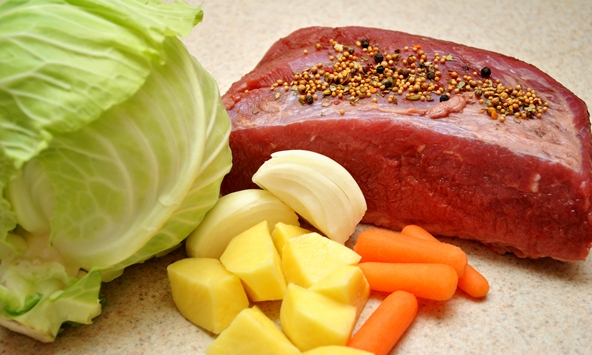A Taste of Irish History
Rutgers University–Camden researcher explains political implications of Irish cuisine

'Food choice is always a political act, and we act politically every day, even if we don’t recognize it in the moment.'- Aaron Hostetter
On St. Patrick’s Day, the whole world seemingly turns green as revelers everywhere savor the holiday with Irish food and drink.
But aside from pleasing the palate, traditional Irish meals, known for their sparse, simple, and inexpensive ingredients, and “Americanized” staples, such as the ubiquitous corned beef and cabbage, are infused with political, economic and social implications, explains Aaron Hostetter, an assistant professor of English at Rutgers University-Camden.
“Food choice is always a political act, and we act politically every day, even if we don’t recognize it in the moment,” says Hostetter, who examines the literary history of food, primarily in Old and Middle English literature.
Traditional Irish cuisine is essentially the food of the poor, consisting of simple, starchy and hearty meals prepared with few ingredients by people with limited means. “Peasants don’t eat peasant food by choice,” he says. “This food is simple, connected to the land, and prepared in primitive ways, such as by boiling meat and potatoes.”
These traditional dishes, however, he notes, weren’t actually designated as “peasant food” until the concept flourished in the United States as a strongly marked alternative to haute cuisine, a standard of French cooking characterized by high-quality ingredients and elaborate presentations. The designation came to mean ethnic European food – including Italian, Polish, German, and Spanish – and was a celebration of both ethnic identity and the United States’ identity as a nation of émigrés.
“The term, ‘peasant food,’ actually comes out of the 20th-century cookbook craze,” says Hostetter. “Peasant food becomes celebrated as everything that haute cuisine is not. It is more accessible to the average citizen because of its simple preparations. Not only does it become symbolic of the ethnic melting pot, it is a pointed response to the excesses and inaccessibility of haute cuisine as a standard.”

Hostetter explains that traditional Irish cuisine was sometimes “Americanized” to reflect new influences and standards of living in the United States. One such dish is none other than the mainstay of St. Patty’s Day, corned beef and cabbage.
For centuries, the Irish have dined on meals utilizing every part of the pig. Beef was too expensive for most Irish and, besides, cows were much more useful to them alive, producing milk and performing work. Conversely, in their new home in America in the mid-19th century, beef was cheaper and more readily available than pork. They were introduced to corned beef – named for the corns of salt used to cure the beef – from their fellow, underprivileged neighbors, most notably the Jews. The Irish then substituted corned beef for pork in homely dishes such as bacon and cabbage, and pork and potatoes.
“Corned beef becomes an ideal or standard of comfort food as the Irish project possibility backwards on what was once a meager meal in their native country,” says Hostetter. “Corned beef still has all of the signifiers of peasant cuisine, but is now an expression of triumphal, American status. It would figure that the main dish of St. Patrick’s Day, an Americanized holiday, is an Americanized dish that no peasants could’ve ever gotten their hands on.”
But perhaps the greatest example of the intrinsic relationship between politics and food is the Irish’s historic – and at times, tragic – connection to the potato. As Hostetter explains, the crop was originally a savior of sorts, becoming a low-cost starch for Irish peasants, when the Spanish introduced it to the New World in the 16th century. The agriculture in Ireland was actually highly developed, as peasants produced grain crops, such as wheat and barley, for England. However, these crops were reserved for export, even when blight decimated potato crops in the 1840s.
As a result, the Irish Potato Famine, which lasted from 1845 to 1852, would claim approximately one million lives and lead to more than one million more emigrants fleeing Ireland. “The blight was a biological event, but famine and starvation are never natural events,” says Hostetter. “The necessity to select certain kinds of food to eat – even when no other viable alternatives are available – is always politically motivated.”
The potato then becomes part of the Irish’s émigré identity in America, he says. By wresting back the crop from failure, it is elevated to a symbol of victory over material circumstances. “There are many instances in which foods that are products of an oppressed identity become celebrated as symbols of resistance,” says Hostetter.
Hostetter adds that the evolving nature of Irish cuisine in America is indicative of American food practices in general, which are often a celebration of advancing status and comfort. These practices are emblematic of what he terms “sovereign consumption” in his research, whereby people eat above their status in order to satisfy their wishes for more luxurious circumstances.
“The American ideal is to eat like rich people do in traditional societies,” he says. “It is a real powerful sign of this yearning to be more comfortable, to be better than we are.”